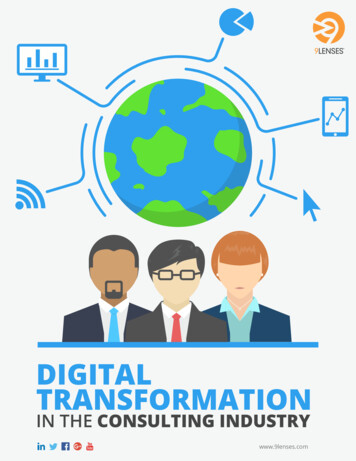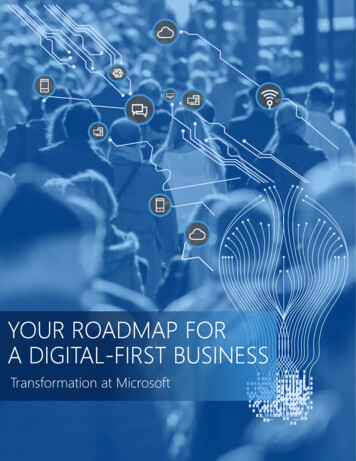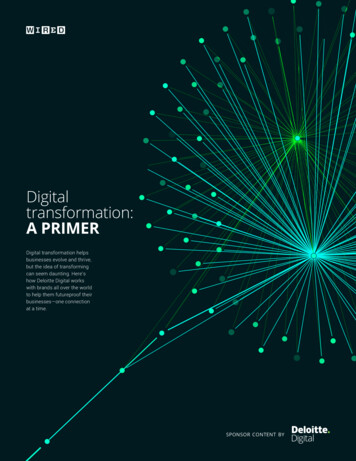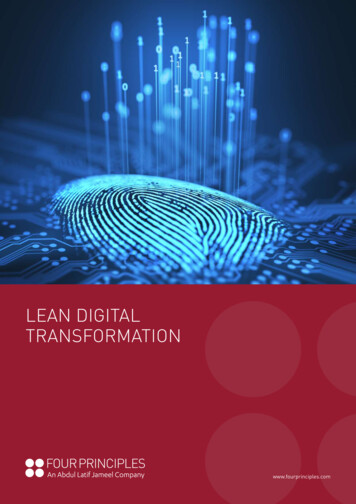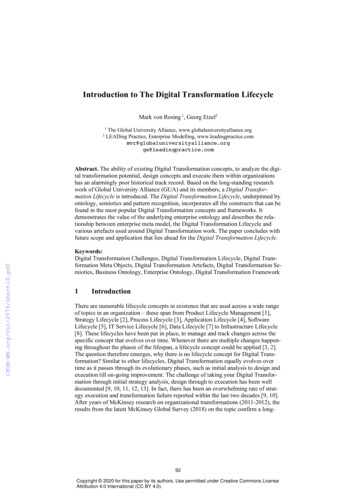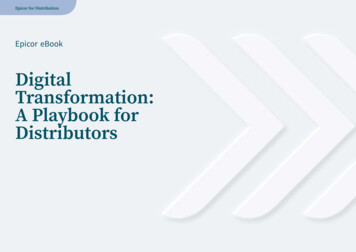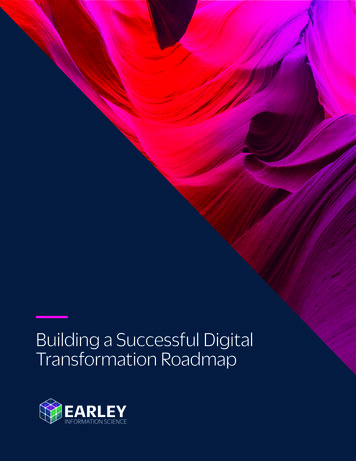
Transcription
Building a Successful DigitalTransformation Roadmap
BUILDING A SUCCESSFUL DIGITAL TRANSFORMATION ROADMAPLaying the Foundation for Digital SuccessAre you ready for digitaltransformation? Do you have adigital transformation roadmap?Does it lay a solid foundationfor a successful transition toyour future digital business? Inorder to succeed, you need tostart with a current assessment,identify gaps and define theactions and resources requiredto fill those gaps along thefour paths of people, process,technology and content.Today’s business leaders are facedwith an overwhelming number ofchoices for digital marketing andcustomer engagement and mustbring together numerous disciplinesCopyright 2018 Earley Information Science, Inc. All Rights Reserved.to best serve the customer andrealize meaningful businessimpact. Organizations need tounderstand their maturity stagein each of these disciplines anddevelop a governance frameworkfor managing the transition to afully digitized enterprise. A maturitymodel can be used to identifyareas for investment that offer thegreatest return and to support thedevelopment of a comprehensiveenterprise roadmap to guide futuredigital marketing initiatives.Most companies know that digitaltransformation is vital to survival,but digital transformation canmean different things to differentHere are some data points:125,000 enterprisesexpect revenue from theirdigital initiatives to increaseby80% by 2020 (Gartner)Digital transformationinitiatives will more thandouble by 2020, from22% to almost 50%(IDC)Only 27% of businesseshave a coherent digitalstrategy for creating customervalue in place (Forrester) 2
BUILDING A SUCCESSFUL DIGITAL TRANSFORMATION ROADMAPPeopleCOMPANIES MUST FOCUS ON JOURNEY MAPPING TOIMPROVE CUSTOMER EXPERIENCEWhich best describes your company's efforts aroundthe customer journey/experienceProcessWe've talked about theneed to do so but no onehas taken the lead yetTechnology3%The need to do sohasn't come up orbeen made a priority12%12%Contentpeople, so it helps to start out witha definition. In its 2014 State ofDigital Transformation report, theAltimeter Group defines digitaltransformation as “the realignmentof, or new investment in,technology and business modelsto more effectively engage digitalcustomers at every touchpoint inthe customer experience lifecycle.”Of the companies Altimetersurveyed for this report, 88 percentwere involved in a formal digitaltransformation effort. But only 25percent had completely mappedout the customer journey orachieved a clear understanding ofall the new digital touchpoints thattheir customers are using.In spite of this, 42 percent of weremaking technology investmentsanyway. The results of the studysuggest that many companies areCopyright 2018 Earley Information Science, Inc. All Rights Reserved.We are researchingcustomer behavior nowand waiting for resultsto inform our digitaltransformation strategy.25%42%We have completelymapped out the customerjourney within the lastyear and have a clearunderstanding of newdigital touch-points.We have not officially researchedthe digital customer journey butwe have updated the digital touchpoints with new social and mobiletechnologies and investmentsmaking either tactical or isolatedinvestments in digital technologyin the absence of a formal,overarching strategy for how thebusiness can optimize the customerexperience. To fully achievesuccessful digital transformation,companies must build a digitalvision and strategy, as well ascreate an information architectureto guide technology choices andto fully leverage investments. 3
BUILDING A SUCCESSFUL DIGITAL TRANSFORMATION ROADMAPDigital Roadmap Components1Start with acomprehensive currentstate assessment1Clearly define afuture vision for yourdigital business2Identify gaps betweencurrent state andfuture visions3Build a roadmap to thefuture along these fourtracks: People, Process,Technology and Content2Systemic ap Tracks4ProcessTechnology4ContentA digital roadmap is an approach to defining and managing a digital transformation effort. Itprovides a structured way to move through the many programs needed to realize success.The roadmap begins with an assessment of the digital maturity of the business today, and moves on toa definition of a future vision. Once the assessment and vision are completed, then it becomes possibleto identify the systemic gaps that need to be filled. Then those steps can be built into the roadmap.Copyright 2018 Earley Information Science, Inc. All Rights Reserved. 4
BUILDING A SUCCESSFUL DIGITAL TRANSFORMATION ROADMAPBuilding a Digital Transformation RoadmapA digital roadmap is dividedinto four major tracks: people,process,technology, andcontent.PEOPLE TRACKPROCESS TRACKThe People Track is about realizingthat superior customer experiencestarts by establishing a customercentric culture in the organization.The Process Track is aboutmaximizing organizationalefficiency, and achieving scalabilityfor the new digital businessmodel. This track requires acomplete customer lifecycleanalysis, including developinga map of the customer journey.You must understand how everybuyer persona engages with yourbrand during every step of thecustomer experience lifecycle.Then it becomes possible tobuild contextualized digitalmarketing campaigns that areIn addition, the people trackaddresses the role of businesspartners in achieving the vision,personalizing the way buyersengage with the brand bothbefore and after the purchase,and then involving everybodyin the company through crossfunctional collaboration.PEOPLE TRACK1People GapsCurrentStateAssessment3Customer Centric CultureYou may need to bridge organizational gapsto create a truly customer-centric culture1Partner Enablement ProgramsSupply chain and sales channels must beenabled to participate in your digital vision2Personalized Buyer EngagementPersonalized buyer engagement will requireconextualized process, technology and content3Cross-Functional CollaborationEvery organizational function must be fullyinvolved and integrated into your systemsCopyright 2018 Earley Information Science, Inc. All Rights EOPLEA superior customerexperience willtranslate to loyalbuyers and highercustomer value. 5
BUILDING A SUCCESSFUL DIGITAL TRANSFORMATION ROADMAPPROCESS TRACK1Process GapsCurrentStateAssessment3Advanced Business IntelligenceUtilize all relevant structured and unstructureddata to drive customer-focused initiatives1Total Operational IntegrationStreamline organizational workflows and dataflows and integrate with marketing campaigns2Digital Marketing CampaignsCreate multichannel, contextualized, data-driven,and measurable digital marketing campaigns3Customer Lifecycle AnalysisPerform a thorough analysis of the customer’sdigital journey for all 6 stages of the lifecyclemuch consistently effective,because they are providing buyerswith exactly what they needat the moment they need it.In addition to a deep focus on thecustomer experience, you shouldalso focus on internal ncyPROCESSDigital transformationwill make yourorganization ascalable andprofitable business.4and people as well. Understandingworkflows and data flowsleads to better operationalintegration, and mining thedata for business intelligenceleads to more productiveknowledge workers and betterbusiness decision-making.TECHNOLOGY TRACKOn the Technology Track, thefocus is on building an integratedinformation infrastructure,which serves as a foundation forintegrating data across silos. Italso is the foundation that enablesall the information managementTECHNOLOGY TRACK1Technology GapsCurrentStateAssessment3Predictive Data AnalyticsThe best use of analytics is to predict customerpreferences for purchasing products and services1Integration of IM PlatformsIntegrating platforms is essential for acceleratingthe clock speed of your organization2Integration of Data SilosIntegrating data silos is critical to achieving 360degree views of your customers and their journey3Contextual Information ArchitectureAn information architecture is the foundationfor a successful digital transformation initiative4Copyright 2018 Earley Information Science, Inc. All Rights ructureTECHAn integratedinformationinfrastructure will be aengine to drive growthfor your digitalbusiness 6
BUILDING A SUCCESSFUL DIGITAL TRANSFORMATION ROADMAPCONTENT TRACK1Technology GapsCurrentStateAssessment3Digital Asset ManagementLarge unstructured digital awards must be taggedand organized for instant access by users1Product Information ManagementHigh volume product data must be easily onboarded,maintained and presented to customers2Enterprise & Site Search OptimizationInternal and external sales should be optimizedfor easy, fast and relevant search operations3Data Quality & GovernanceAll enterprise information should be cleansed,contextualised and controlled by quality standards4platforms to interact, andallows for the predictive dataanalytics that drive growth.It is important to keep in mind thatyour technology strategy is onepart hardware, one part software,and one part information science.A contextualized informationarchitecture is critically importantfor structuring data and contentwhile tagging them with theappropriate metadata for"your technologystrategy is one parthardware, one partsoftware, and one partinformation science."Copyright 2018 Earley Information Science, Inc. All Rights Reserved.defining relationships betweenclasses of information.Your information architectureshould reflect the landscapeof your business. This requiresclose collaboration betweenthe business stakeholders inyour organization and the ITpractitioners that will build aninfrastructure to deliver businessvalue - Business value that comesin the form of personalizedcustomer experiences andmarketing programs, accuratebusiness insights and moreefficient business processes.CONTENT TRACKFinally, the Content Track isfocused on managing bothinternal enterprise information andcustomer facing content, ensuringthat it is accurate, findable byyour audience, personalized, andcontextualized. Context TAll internal andcustomer-facingcontent should beaccurate, easilyaccessed anduser-personalizeddetermine how information isorganized. This evaluation needsto be done across all digital assets,so that product information isorganized contextually to reflectbuyer preferences. Enterprisesearch and external site searchare optimized to make the mostrelevant content findable. Datagovernance processes will ensuredata quality and accuracy.Finally, getting some quick winsthat show business impact willhelp obtain support throughoutthe transition. Transformationprograms may be massive andtake place over multiple years, butunderstanding the ROI for eachphase helps keep a multi-yearjourney on track. With a structuredapproach, all of the moving partscan be managed and progresssustained throughout this journey. 7
BUILDING A SUCCESSFUL DIGITAL TRANSFORMATION ROADMAPAvoid Digital FragmentationOne consequence of the lackof foundational planning is thatorganizations end up with toomany disconnected initiatives,or “digital fragmentation.” Theseinitiatives need to be unifiedbefore an organization can realizethe full potential of its digitalvision. This can be a difficultprocess because each initiativeoften has its own businessjustification and funding.The problem with fragmentedinitiatives is they are often notwell aligned with the company’sstrategic goals. They maybe a reaction to short-termmarketplace events, rather thana true reflection of long-termbusiness goals. Without a digitalroadmap, organizations runthe risk of buying technologieswithout a clear understandingof their role in driving toplevel business erExperienceGlobal Engineering/Knowledge ProcessMobileEngagementBig DataAnalyticsCopyright 2018 Earley Information Science, Inc. All Rights Reserved."Organizationsthat experiencethe greatestdigitaltransformationsuccess startwith vision andstrategy."Organizations that experience thegreatest digital transformationsuccess start with vision andstrategy. They asses their currentstate capabilities. They knowwhere the gaps are and then theychart the roadmap. The roadmapincludes all of the people,process, technology, and contentchanges that need to be made. 8
BUILDING A SUCCESSFUL DIGITAL TRANSFORMATION ROADMAPStart with Vision and StrategyHaving the right vision and gettingthe organization to agree on theobjectives for transformation,without getting intoimplementation details is criticallyimportant. The right vision getseverybody on the same pageand the right strategy for gettingthere creates understandingfor how to realize that vision. Adigital transformation roadmapaligns technology resourcesand programs to the businessgrowth strategy of the firm. Onlythen can the team get to a pointwhere it can start to talk aboutimplementing technologies,implementing business processes,hiring people with the right skills,and building organizations.Upscale retailer Nordstrom isoften described by industryobservers as a leader in digitalexperience. Nordstrom had avery clear picture in mind whenit set out on a multi-year digitaltransformation initiative. In theirvision of a digital future, a customercould walk up to an associate inany store and the associate wouldhave access to all informationabout that customer—their priorpurchases, profiles, preferences,wish lists, recently viewedproducts—so that the associatecould support that customer withan ideal in-store experience.Nordstrom’s goal was, and is, tosupport a seamless transition ofthe digital customer experiencefrom the online environment tothe in-store experience. This wouldenable attending to the needsof a customer at a register, on apoint-of-sale display, a companykiosk and also on their own mobiledevice. That means enabling theintegration of customer dataacross all of those touchpoints.Knowing the desired end resultprovides insight about thenecessary steps to take alongthe way and how to arrive atthat result. Vision is key todifferentiating between adequatedigital transformations and trulyoutstanding and successfuldigital transformations."A digital transformationroadmap alignstechnology resourcesand programs to thebusiness growth strategyof the firm. Only then canthe team get to a pointwhere it can start to talkabout implementingtechnologies"Copyright 2018 Earley Information Science, Inc. All Rights Reserved. 9
BUILDING A SUCCESSFUL DIGITAL TRANSFORMATION ROADMAPFocus on the CustomerDigital transformation is a journeywill impact every part of yourorganization. It starts with afundamental concept of beingcustomer centric in everythingyou do. As you begin to managethe complexities of organizationalchange, process improvement,technology integrationand content management,remember to make the customerexperience a primary objective.With that frame of mind,objectively assess your currentstate, create your futurevision, identify systemic gaps,and structure your digitaltransformation initiative alongthe four tracks of people, process,technology, and content.to continuously assess yourprogress. In the end, you willposition your business to delivera digital customer experiencethat will attract more buyers,maximize digital revenues,maintain customer loyalty anddifferentiate your brand in thecompetitive marketplace.Be sure to set achievable businessgoals and measurable metricsto manage the process andPUTTING IT ALL TOGETHER1Systemic sisProcessPredictiveDataAnalyticsIntegrationof IMPlatformsIntegrationof ntEnterprise& Site SearchOptimizationDataQuality& GovernanceContentCopyright 2018 Earley Information Science, Inc. All Rights Reserved.Superior CustomerExperienceMaximum OrganizationalEfficiencyIntegrated InformationInfrastructureOptimizedContent Management 10
About Earley Information ScienceEarley Information Science is a professional services firm dedicated to helping organizations just like yours becomean AI-powered, customer-driven enterprise. We have the tools, team, and processes to design and execute ascalable, governance-driven digital roadmap, led by your customer’s immediate and long-term needs. Together,we can implement a digital transformation that provides a personalized, accurate, and fulfilling customer journey,driving measurable ROI to your bottom line.PO Box 292, Carlisle, MA 01741P: 781-812-5551www.earley.com
Altimeter Group defines digital transformation as "the realignment of, or new investment in, technology and business models to more effectively engage digital customers at every touchpoint in the customer experience lifecycle." Of the companies Altimeter surveyed for this report, 88 percent were involved in a formal digital





